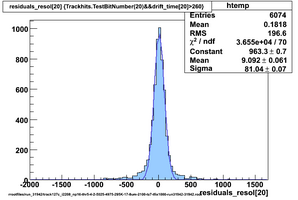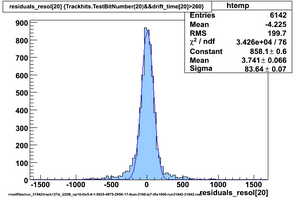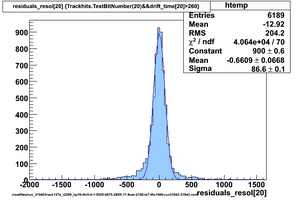Difference between revisions of "CDC algo tuning"
From GlueXWiki
| Line 1: | Line 1: | ||
| − | Using prototype data from [[CDC_50_50]] (run | + | Using prototype data from [[CDC_50_50]] (run 31942) with offline analysis |
50/50 Ar/CO<sub>2</sub> and cosmics, 2100V, prototype horizontal | 50/50 Ar/CO<sub>2</sub> and cosmics, 2100V, prototype horizontal | ||
Revision as of 22:08, 4 December 2013
Using prototype data from CDC_50_50 (run 31942) with offline analysis
50/50 Ar/CO2 and cosmics, 2100V, prototype horizontal
Original code, many samples upsampled
- Event pedestal is mean of 100 samples ending at trigger time
- Find hit threshold crossing
- Step back <pedlead> points to find new pedestal
- Search forward to find high threshold crossing
- Search backward to find low threshold crossing
- Project through both thresholds to find pedestal crossing time
Fewer samples upsampled
- Event pedestal is mean of 100 samples ending at trigger time
- Find hit threshold crossing
- Upsample region around threshold crossing, with threshold crossing sample in set position
- Step back <pedlead> points to find new pedestal
- Search forward to find high threshold crossing
- Search backward to find low threshold crossing
- Project through both thresholds to find pedestal crossing time
Ideas
- Check whether interpolating threshold xings makes any difference - no, not if extrapolating through thresholds to pedestal.
- Use the 3rd sample (or mean of 3rd & 4th samples) before hit threshold as local pedestal
- Try reverting to one threshold crossing instead of the extrapolation - only slight increase to res width
- Try something easier for event pedestal - mean of 4 samples immediately before trigger





